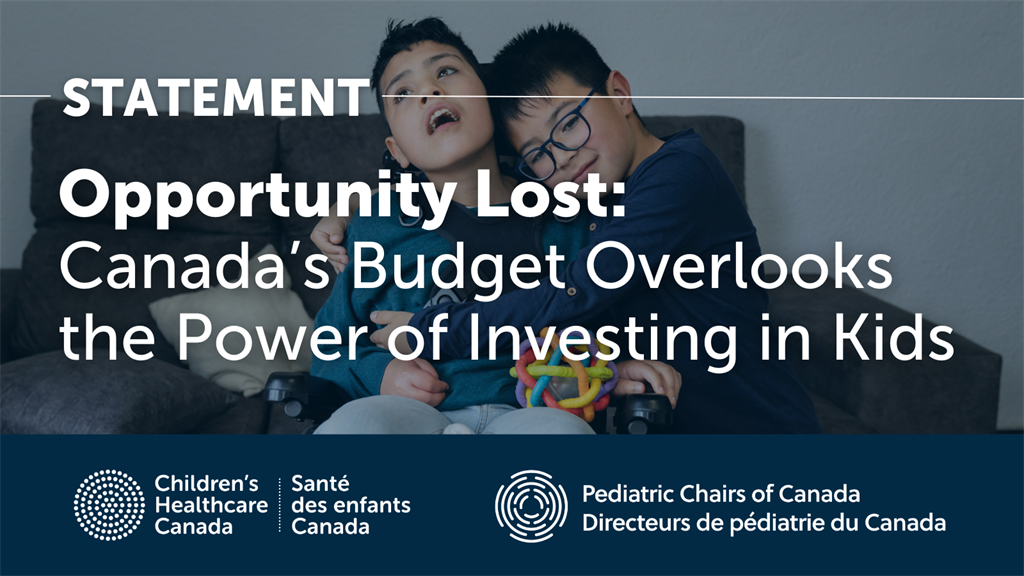Investments in Children’s Developmental, Physical, and Mental Health and Well-Being Bring Results
November 05, 2025
“The conclusion we can draw from literature studying the relationship between children's health and the economy is that making greater investments in children's health and well-being results in better educated and more productive adults and sets in motion favourable demographic changes,” says EKO President & CEO Jennifer Churchill. “Safeguarding health during childhood is more important than at any other age; failing to address children's developmental, physical, and mental health and well-being in the early years is likely to impact them over the course of their life.”
Read Children’s Healthcare Canada’s and Pediatric Chairs of Canada’s joint response to the federal Budget 2025.

Opportunity Lost: Canada’s Budget Overlooks the Power of Investing in Kids
OTTAWA – November 4, 2025
—
The federal budget has been tabled, and the Liberals are hard at work getting the votes to pass it this week. The budget includes important investments in health infrastructure, affordability, and youth employment. However, for children, most of the announced funding measures are too downstream to make a difference for them.
Children’s Healthcare Canada (CHC) and the Pediatric Chairs of Canada (PCC) welcomed the government’s continued commitments to the national school food program and affordable childcare. New investments in talent attraction for researchers, foreign credentialling of healthcare workers, and health infrastructure will support the sector broadly. Alongside our members, we will work hard to ensure these initiatives don’t leave child health on the sidelines.
Since the start of the 45th Parliament, Children’s Healthcare Canada and the Pediatric Chairs of Canada have urged the federal government to put children’s health back on the national policy agenda. Alongside many partners, we have been steadfast in our advocacy for strategic, measurable investments that improve experiences and outcomes of care, strengthen families, and build a more equitable future.
For example, a notable omission from the budget is Jordan's Principle, and the Inuit Child First Initiative. CHC will pursue meetings with Indigenous Services Canada to advocate for continued support and improvement of this program.
So while Budget 2025 lays some promising groundwork, the important work now begins—ensuring these investments translate into better health for children and youth across Canada.
Why It Matters
UNICEF’s Report Card 19 (2025) ranks Canada 24th out of 36 high-income countries for children’s physical health and 33rd for adolescent suicide. These outcomes are not inevitable—they reflect policy choices.
The Thrive report, prepared by Deloitte and commissioned by Children’s Healthcare Canada and Canada’s Children’s Hospital Foundations, shows that every dollar invested in children’s health and healthcare yields up to $5 in return through improved productivity, reduced chronic disease burden, and stronger communities.
While Budget 2025 includes welcome funding to support health research, international recruitment initiatives, and infrastructure renewal to strengthen Canada’s universities and hospitals—it stops short of directing any of these resources toward addressing the crisis in children’s physical and mental health. Without a clear plan or targeted funding for children's health priorities, Canada risks falling even further behind its peers.
Budget 2025 was an opportunity for Canada to change course and put children, youth and families on a trajectory to thrive. It missed the mark—but the work continues. CHC and PCC will continue to push for coordinated, accountable action through Bill S-212 and beyond, to ensure that children and youth are no longer an afterthought in Canada’s fiscal and policy decisions.
When we invest in the health of children, we invest in the health of Canada.
About Us
Children’s Healthcare Canada is a national association representing organizations that deliver health services to millions of children and youth each year. Its members include all 16 children’s hospitals, community hospitals, rehabilitation hospitals, home and respite care agencies, children’s treatment centres, and regional health authorities. CHC advocates to accelerate excellence and innovation in health systems serving children, youth, and their families across the continuum of care.
The Pediatric Chairs of Canada represents the department heads of pediatrics within Canada’s 17 medical schools. PCC provides national leadership to advance pediatric education, research, and workforce planning in support of high-quality care for children and youth.